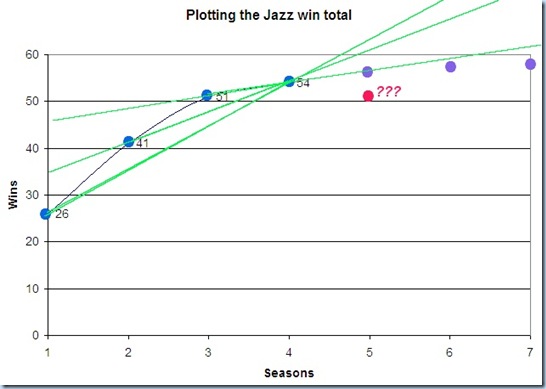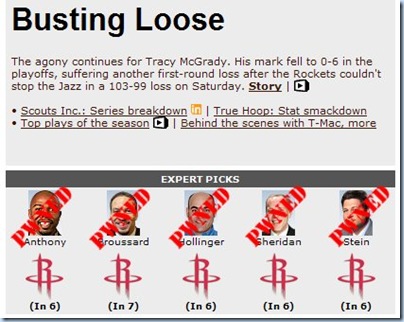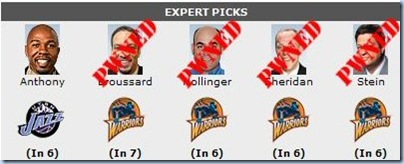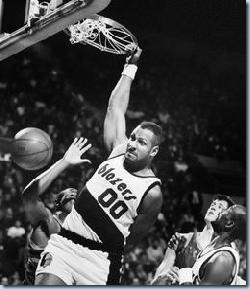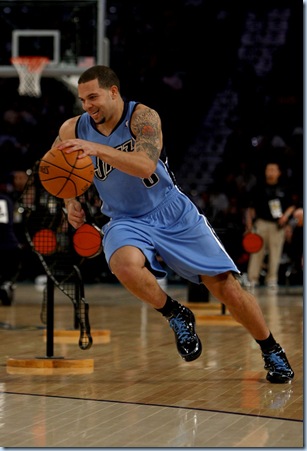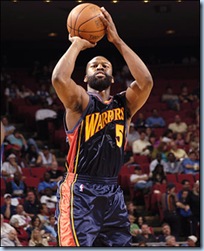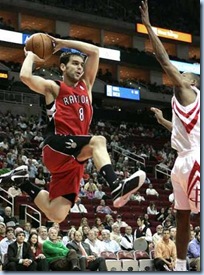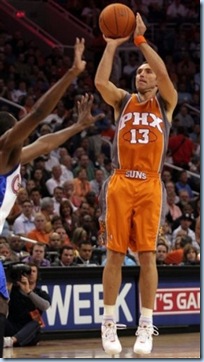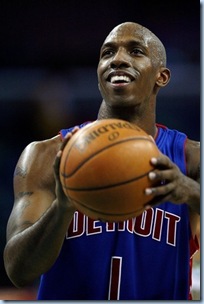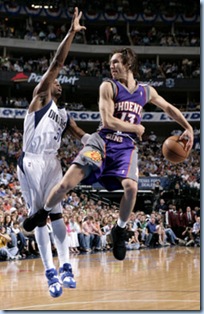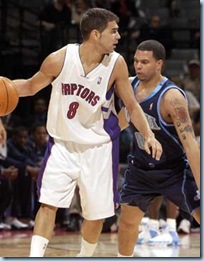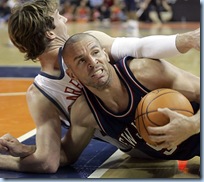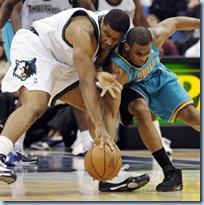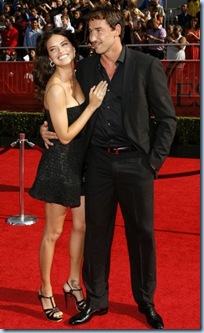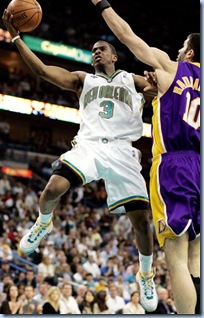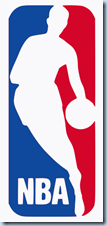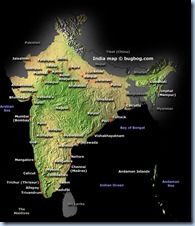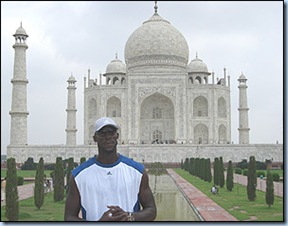Anything is possible? Photo courtesy of Adidas . . . and yes, that's Kevin Garnett in Agra, India
I first heard about this story from a
Tom Ziller blog @ the
Fanhouse. It's taken me some time to really get my feelings about this subject, obviously so as this story is over a month old now. Really, how conflicted should I be -- my favorite sport to watch on TV is basketball, and I used to live in
India and complain about the lack of
NBA coverage there. (
You can imagine me getting to the hospital late some mornings because I was waiting on ESPN's Java based monster to update the score of some meaningless Jazz/Sonics regular season game back in 2002 -- gotta love that +10:30 time difference)
| David Stern has recently been talking up international basketball because of the Olympics. The NBA/China link is quite established, and plans for establishing a basketball league in that nation currently exist. "[Though] Stern said the [NBA] does not see China as an entry point to Asia. India could be next on the NBA's radar. Stern said NBA officials have met in Beijing with Indian authorities, and the league stages its first Basketball Without Borders events in India this summer. "We think that [India] is a very promising market." (Andrew Bagnato, AP sports writer via. CBC Sports) Getting involved in China seems like a slam dunk with their large population, potential economic force and active NBA players (Yao and Yi). | 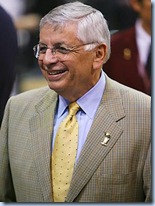 |
There are no major Indian basketball players knocking on the door to the NBA like Yao Ming (and others before him) did a few seasons ago. This appears to be a major obstacle for the provincialistic keepers of basketball, if not for the nation of India itself. When people talk about basketball on the international level, no one really even talks about FIBA Asia -- let alone a country that is getting beat down by Quatar and Kazakhstan by a combined 80 points. I guess the point that most detractors have is that a nation that does not display great skills at something may not be a big fan of it. Essentially, if India doesn't produce great basketball players, how will basketball ever be popular there? If I wanted to be smarmy, for a rebuttal I'd suggest that the United States of America seems to be in love with democracy, even if we currently don't really have one. (we live in a republic, deal with it) But let's not go there . . .
 | For all of India's historical records in the sport (last place in the 1980 Olympics; btw, Andrei Kirilenko's father-in-law / Masha's dad was on the USSR team in 1980 -- Andrei Lopatov); and apparent disinterest (if you're not playing Cricket, you better get your ass a book and study) -- the Indian subcontinent has one big thing going for it: Potential. |
Like the risk/reward system of drafting an unproven high school kid, and how it used to challenge GM's (back when you could draft high school kids on the premise that they could become like a Kobe, KG, or LeBron), the NBA is basically drafting India based on potential. The first, and only really bankable potential that India has right now is the economic potential.
"[India] is the twelfth largest economy in the world, with a GDP of around $1 trillion (2008). It recorded a GDP growth rate of 9.1% for the fiscal year 2007-2008 which makes it the second fastest big emerging economy, after China, in the world." (Wikipedia, 2008)
India has one of the higher natural increase growth rates in the world, and already consists of one sixth of the entire population of the world: China's population is 1.3 billion, India's is 1.1 billion (CIA, 2008). India is on the rise, and there is a lot of money to be made there. Many Multi-national corporations (of which the NBA definitely can be classified as) have been going to India in the last few years -- you see McDonald's and Subway franchises there, Target retail superstores have come to India, and many more such companies have landed, or are planning on doing so in the near future. Adidas opened up stores there and sent Kevin Garnett to India in 2006-2007 to drum up hype.
| | KG in Delhi: the landing, the announcement, and the spectacle of the Big Ticket as he does everything from signs autographs to watching some Desi pick up ball in a gym. Click to see Agra (Taj Mahal), and Bangalore. Essentially, Adidas made some money. |
"Expanding to the world's second most populous market hardly seems loony. After all, no American sports league has exported its brand better than the NBA, which sells more than $750 million in merchandise overseas annually. Its games are broadcast in 215 countries. And India offers a growing, tech-savvy economy with a billion potential consumers -- 60% of whom are below age 30 -- who could sop up NBA merchandise and follow their favorite players on NBA.com." (Sean Gregory for Time Magazine, 2006)
According to the CIA World Factbook entry on India, there are over 233.62 million cell phones in use there (5th in the world), and over 60 million Internet users (5th in the world). There are 562 TV broadcasting stations as well. That is a lot of potential exposure that the NBA could be getting -- and that exposure almost always results in someone making money. (Which TV exec wouldn't want to make an exclusive TV deal for a potential 1 billion viewers?) Money is reason enough, especially in a nation that proves to be so important in the future (not just as a big market, but as the largest democracy by population in the world, and as a possible pro-Western society that is neither Islamic, nor Socialist -- unlike the other big nations in FIBA Asia). India also has other reasons to be lucrative for David Stern and the rest of the head office boys at the NBA.
As far as control of the globe is concerned, the NBA and FIBA are in a fight against FIFA, and the rest of those soccer/futbol playing nations. Some nations are able to be both basketball and soccer hotbeds (like Brazil, Argentina and so forth) -- but the NBA and FIBA really need to establish themselves in those nations that are still clearly undecided in the FIBA/FIFA war. India is one of those nations. Like the United States (with the love of football and baseball being huge) and Canada (with hockey), India is a place where basketball will have a hard time being number one. (Thanks to Cricket)
India has just recently started a cricket league (actually two, in some crazy, mixed up NBA/ABA issue that deals with cricket, instead of basketball, and a lot more legal action) -- and the popularity of that sport is only getting bigger. A few months ago I was eavesdropping on a conversation two Indian immigrants were having in line at the DMV here in Detroit. They were checking their Indian Premier League cricket scores on their cell phones and talking about it.
"Marketers got a glimpse of the potential of professional sports' in India earlier this year with the debut of the Indian Premier League, a flashy cricket [regular season and playoffs] that brought the sport's biggest international stars together with big advertisers, big crowds -- and big money." (Sam Dolnick, AP via The Nashua Telegraph, 2008)
FIBA/The NBA wants part of this pie, before an internal soccer league gets set up and popular in India. Part of the directed goals so far seem to actually revolve around making it easier for Indian cell phone users to check NBA scores from their devices -- which is so ironic when put in context with my DMV story:
"The NBA is talking to Time Warner about producing hoops-related programming on [Time Warner's children's channel on Indian airwaves] and to ESPN Star Sports . . . about increasing the league's presence on the network's Indian sports channels. The NBA is also in discussions with Nokia about supplying league content on Indian mobile phones." (Sean Gregory for Time Magazine, 2006)
Still, India has more to offer the NBA head offices besides money and market shares. India is a very stratified nation. As far as stratified societies go, India is among the best in the world at it. While most people consider India to be one of the poorest nations in the world, 4 of the Top 10 wealthiest billionaires are Indian. That said, India has an emerging and important middle class. (Who do you think is watching all of that TV and using all those cell phones?) This middle class is seeking an identity.
The richest of the rich, highest class (nouveau caste, really) of modern Indian appear to be a much different phenotype than the rest of India. They are the ones who you see on Indian TV or in Indian movies that are nearly the personification of modern day idols and Gods on earth -- in India. The tallest, fairest, most un-Indian (yet distinctly Indian) Indian people around.
Any of these Indians looks like someone who works in IT, a 7/11 or in your local ER? Nope. But out of a population of over a billion, you are bound to get enough people who look and live like they do. The richest people in India have the most advantages . . . and love to appear beyond that of the common rabble. Hence, they are clearly the market the NBA is after. After all, the NBA is already "seeking endorsements from Bollywood stars," (Sam Dolnick, AP via The Nashua Telegraph, 2008) of which the six above clearly are. Additionally, Indian films have been using subtle propaganda to establish basketball as something new, hip and elite: Parampara (1993) was the first time I saw basketball in Bollywood -- where the guys playing basketball used a soccer ball; Kuch Kuch Hota Hai (1998) uses basketball (with an actual ball, this time) as a story driven device; and Koi ... Mil Gaya (2003) has a "a nerdy hero [who gets] Jordaneqsue abilities." (Sean Gregory for Time Magazine, 2006)
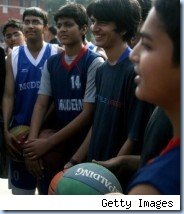 | "Basketball is most popular among cosmopolitan Indians, for whom the game carries a whiff of Western sophistication. America's ultimate gritty playground game has, in India, largely become a game for the children of the elite. "My students, they go to U.S., Europe, and there they have so much of a basketball culture," said Deepak Shukla, who coaches a basketball team at an exclusive New Delhi school. "They have Shaquille O'Neal shoes they get from [America] . . . my students are from (wealthy) families . . . [eventually] only the poor people will play cricket." "(Sam Dolnick, AP via The Nashua Telegraph, 2008) |
While the poorer people can divert themselves with playing cricket, the Middle class wants to elevate themselves as well -- why not with the highest flying game on the planet? David Stern is cautiously optimistic:
"With [India's] middle class and some focus on the world's games, basketball is starting to get a little interest and a little traction . . . so we have to be respectful and realize it's going to be small steps up." (David Stern, as reported by Sean Gregory for Time Magazine, 2006)
Naturally, if David Stern is interested -- it's in the obvious best interest for the league. As such, this past summer before the 2008-2009 season they did have their first Basketball Without Borders trip -- among those who participated were Rony Turiaf, Kyle Korver, Linton Johnson, Pat Garrity and former players Dominique Wilkins and Sam Perkins.
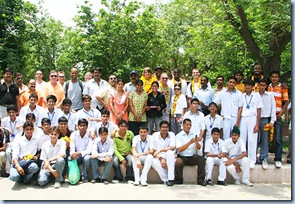 |  |
| New Delhi: The group poses after being greeted | Agra: Kyle Kover said that it was "like 150 degrees [outside]" (NBA.com, 2008) |
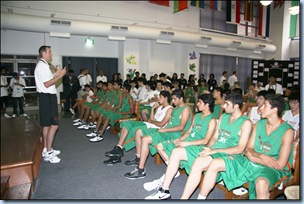 | 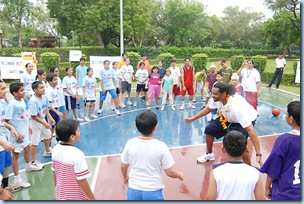 |
| New Delhi: Pat Garrity talks to campers | New Delhi: Sam Perkins asks where he can get that really good Buddha from |
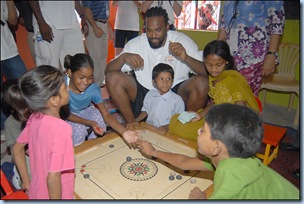 |  |
| New Delhi: Rony Turiaf plays Karem with kids | New Delhi: Dominique Wilkins teaches a drill |
| |
| Dominique Wilkins and Kyle Korver (who is called one of the greatest to ever play, and smiles accordingly) are interviewed on CNN's Indian station (CNN-IBN). 'Nique likes the discipline the kids show, Kover suggests that you can still be good at basketball when you're short -- look at Iverson. |
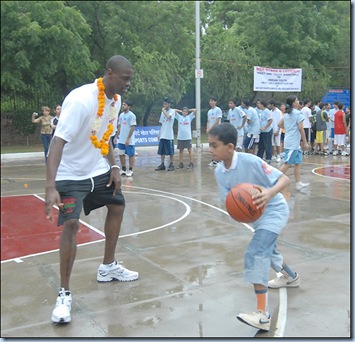 | Basketball requires a lot more infrastructure than India currently affords their most rural areas. Additionally, when I last lived in India (2002) even the most exclusive sporting clubs and health spas were not a lock to have a basketball courts.
Basketball without Borders programs increase awareness (and also do other things, these guys talked about everything from Zone defense to Aids prevention), and training of younger players.
I fully expect the NBA to send players back in the following summers. It seems like the perfect sport to grow roots in India's growing middle class, if not also in their upper class as well. |
| New Delhi: Linton Johnson plays with his haar on. | |
So it is realistic to say that in the next 20 years, with proper time and development, India could be pretty okay at basketball -- and maybe have a much stronger international presence on the courts. Furthermore, the NBA in India makes a lot of fiscal sense. Will there be an NBA player who is Indian? Probably one day, as countless kids of Indian origin play basketball all over the world -- be they a street ball player from Australia, or any number of the countless Indian undergrad students in the USA and Canada who play daily. It's not outside the realm of possibility to see someone from India be NBA ready at some stage -- but it make take a genetic freak like a 7'5 player to first do it. And really . . .
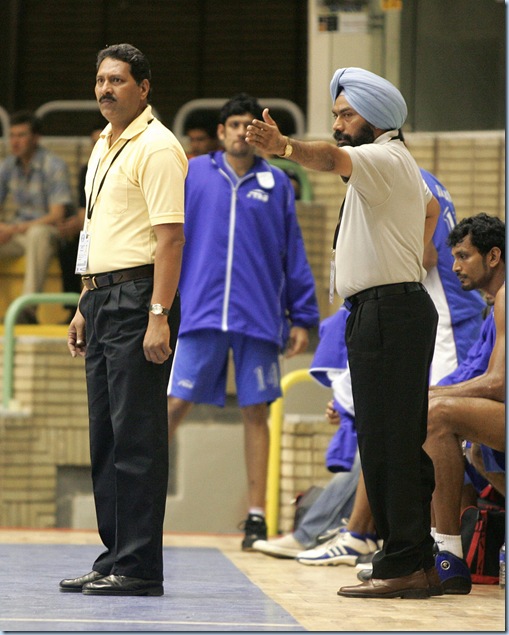 |
| Don't you want to see this guy in the Turban as an assistant coach for some team? He could even color coordinate his turban to if it was a road or a home game! P.S. I'm not making fun of you Punjabi Sikh guys at all, just *THIS* Punjabi Sikh guy. |

